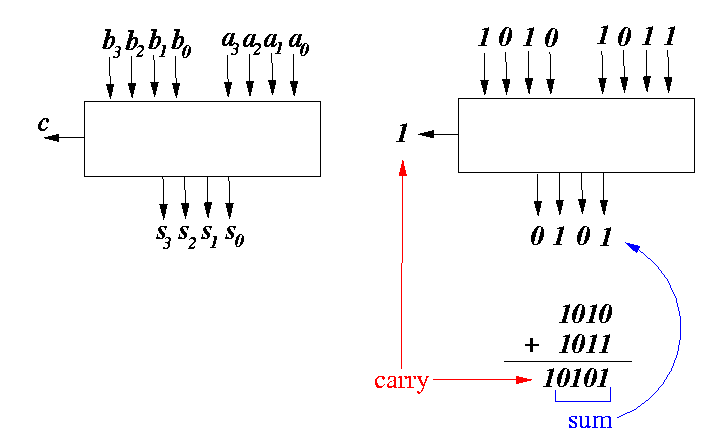Intro to arithmetic circuits
- From CS255:
- The computer can
only perform
arithmetic and logical operations on
(binary) numbers
|
- In addition to
switching circuits
(e.g.: multiplexor,
decoder, ...),
a
second major category of circuits
found inside the CPU
are
circuits that do computations:
- Arithmetic operations:
addition,
subtraction,
multiplication and
division
- Logical operations:
AND, OR,
NOT, etc
|
|
Arithmetic circuits studied in CS355
We will study
how to construct
the following
arithmetic circuits:
- The ripple carry adder
circuit that can
perform
addition of
binary numbers
- A subtraction circuit contructed
using the ripple carry adder
- A multiplication circuit
constructed using
(multiple)
ripple carry adders
- (We will not study
circuits that performs
division - it's
too time consuming, we need the time to explain
the other operations
within the computer)
|
How to make
arithmetic circuits in
general
The general approach to
design/construct
any
arithmetic circuit is
to use the
circuit design methodology
discussed
previously:
- List out
every combination
of the input values
- Determine
the output for
each combination
of input values
- Construct the
digital circuit using
NOT,
AND, and
OR gates
|
See this
teaching slide set:
click here
However:
when you use this circuit design method,
you will
not be able to
make a viable cuicuit !!!
Applying the general circuit design technique on a
"4 bit adder" circuit
Suppose we want to
design a circuit
that can add
two
4-bits (binary) numbers:

Applying the general circuit design technique on a
"4 bit adder" circuit
The
logic table
for this
4-bit adder circuit will
look like
this:

The logic table for a
4 bit adder has
28 (= 256) rows !!!
Why the general circuit design method fails
- An adder circuit to
add
two
32 bit binary number will
have
264 rows
- 264 rows =
18446744073709551616
= 18446744 trillion !!
We can never make
this many number of
transistors, so let alone
AND, OR, NOT gates
(that are made up of
transistors) !!!
|
We must make some
trade offs in order to
make
viable
32 (or larger) arithmetic circuits
❮
❯

